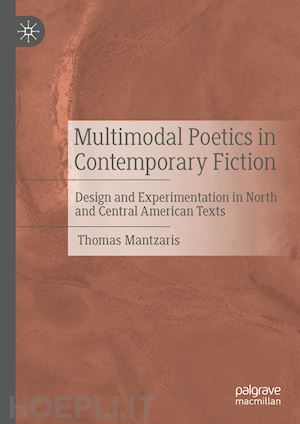
Questo prodotto usufruisce delle SPEDIZIONI GRATIS
selezionando l'opzione Corriere Veloce in fase di ordine.
Pagabile anche con Carta della cultura giovani e del merito, 18App Bonus Cultura e Carta del Docente
This book explores the growing body of multimodal literary texts: books that creatively experiment with the potential of design to represent narrative content. Examining five North and Central American novels from the first two decades of the twenty-first century, this study draws attention to texts that combine verbal text (writing) with non-verbal elements (photographic images, varied typography, maps, color, etc.) as integral parts of their narratives. Their experimentation both reconfigures the potential for print-based (and born-digital) fiction in the future, and holds a mirror to past practices of design and typography that were rendered invisible, or which received limited attention by authors, publishers, and readers. By placing the five case studies and related texts within a broader history of experimentation in literature, this book demonstrates how multimodal novels have changed the conceptualization of narrative content in literary texts and ushered in a new era for fiction.
Chapter 1. Introduction.- Chapter 2. Relaunching the Print Novel: Mark Z. Danielewski’s House of Leaves.- Chapter 3. Enhancing the Print Novel: Jonathan Safran Foer’s Extremely Loud & Incredibly Close.- Chapter 4. Layering the Print Novel: Handwriting and Material Artifacts in J.J. Abrams and Doug Dorst’s S.- Chapter 5. Crafting the Print Novel: Book Design and Narrative Content in Zachary Thomas Dodson’s Bats of the Republic: An Illuminated Novel.- Chapter 6. Archiving the Print Novel: Valeria Luiselli’s Lost Children Archive.- Chapter 7. Epilogue.
Thomas Mantzaris is an affiliated researcher at Vrije Universiteit Brussel, Belgium. His research interests include multimodal and experimental narratives, contemporary American and Anglophone fiction, printed books, and photography.











Il sito utilizza cookie ed altri strumenti di tracciamento che raccolgono informazioni dal dispositivo dell’utente. Oltre ai cookie tecnici ed analitici aggregati, strettamente necessari per il funzionamento di questo sito web, previo consenso dell’utente possono essere installati cookie di profilazione e marketing e cookie dei social media. Cliccando su “Accetto tutti i cookie” saranno attivate tutte le categorie di cookie. Per accettare solo deterninate categorie di cookie, cliccare invece su “Impostazioni cookie”. Chiudendo il banner o continuando a navigare saranno installati solo cookie tecnici. Per maggiori dettagli, consultare la Cookie Policy.